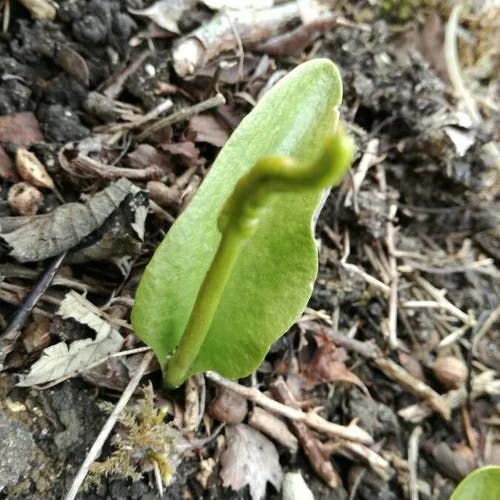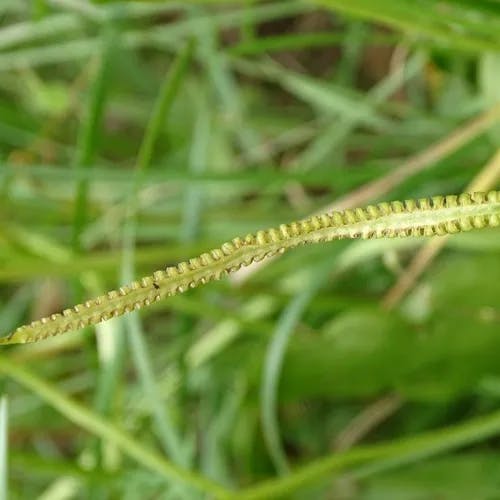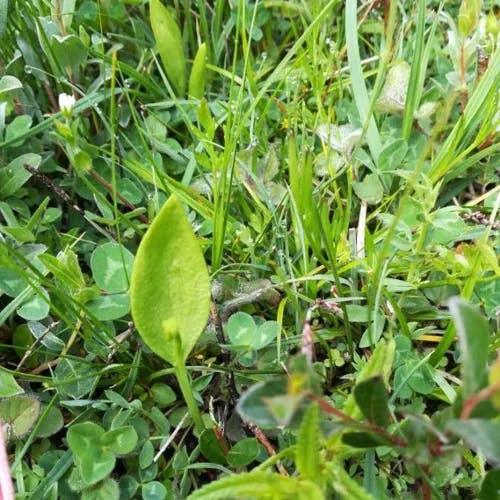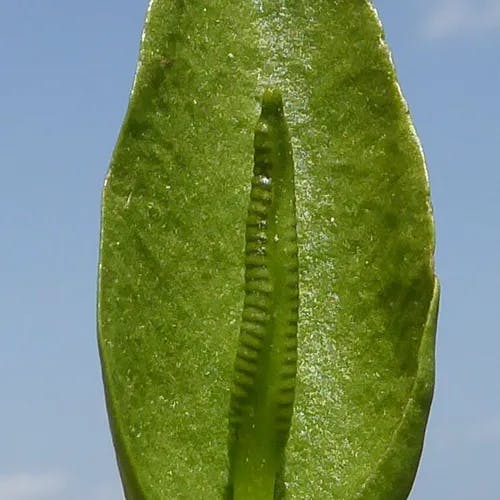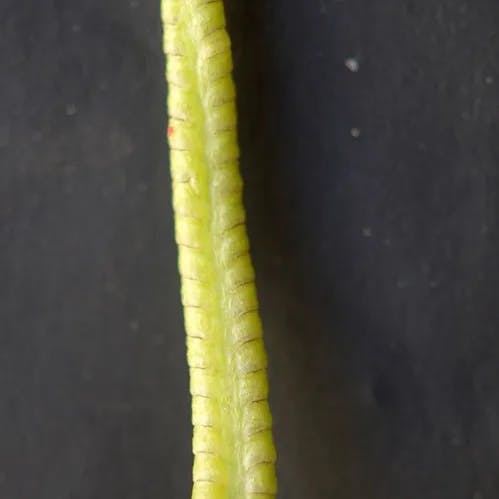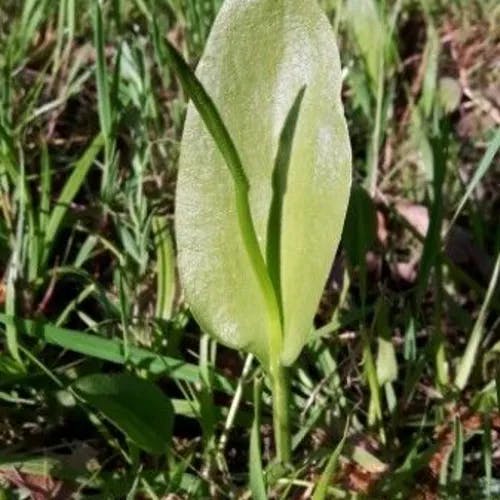The perennial plant Ophioglossum vulgatum produces inconspicuous yellowish-green flowers. Its cylindrical stem can reach up to 30 cm tall. This plant is not commonly cultivated in gardens. The adder's tongue has a smooth green stem and dark brown leathery fertile frond. It bears sporangia containing reproductive spores. The sterile fronds are green and photosynthetic. Ophioglossum vulgatum grows in shaded, moist areas with rich soil in temperate regions of Europe, Asia, and North America. It belongs to the Ophioglossaceae family and has an unbranched stem. The adder's tongue is appreciated for its contribution to habitat biodiversity rather than symbolic significance. Its unique appearance interests botanists and taxonomists.
Adder's-tongue
- Scientific name
- Ophioglossum vulgatum
Basic Information
- Ophioglossaceae Family Ophioglossum Genus Adder's-tongue Species
- Ophioglossaceae > Ophioglossum > Ophioglossum vulgatum
- 83%
- The Completeness of This Encyclopedia
Please help us complete the encyclopedia, Terrarium is a encyclopedia service to be completed with everyone in the world. Currently, this page is 83% complete. For more information on how to contribute, please click here.
- Forb/herb
- Pteridophyta
- Height
- 20cm ~ 50cm
- Flower Color
- Leaf Color
- Anthesis
- Sunlight Exposure
Full Sun Long hours of sunlight from morning to afternoon Partial Shade A location in the shade of a tree or where either the morning or afternoon is shaded Full Shade A place where there is no direct sunlight
- Partial Shade
- Hardiness Zones
This is an indicator to know to which zone each plant can winter. Knowing the zone of each plant gives you an idea of the cold temperature resistance when grown in the ground without a roof. 2: -42.7 to -40.0 3: -39.9 to -34.4 4: -34.3 to -28.9 5: -28.8 to -23.3 6: -23.2 to -17.8 7: -17.7 to -12.2 8: -12.1 to -6.7 9: -6.6 to -1.1 10: -1.0 to 4.4 11: 4.5 to 10.0
- 5-9
- Cold resistance
- Good
- Heat resistance
- Fair
- Habitat of origin
- Europe, Asia, North America
- Growth Rate
- Normal
What is Adder's-tongue (Ophioglossum vulgatum)?
What is Adder's-tongue (Ophioglossum vulgatum)
Flower meaning
Adder's-tongue does not have a common flower language in America. This plant, scientifically Erythronium, has no meaning in the American system. Flower meanings change over time and between cultures. Roses mean love, lilies innocence. But no flower represents a birth month.
Calendar of Adder's-tongue (Ophioglossum vulgatum)
Calendar
Adder's-tongue's stunning flowers show their complexity in spring. The plant needs sufficient nutrients and sunlight not to wilt during its weeks-long blooming. While blossoming, the species, known also as Ophioglossum, contributes elegance. Adder's-tongue occurs in the United States, where its flowering time is April and May. For best blooms, remove weeds and ensure water. Ample sunlight also helps. The plant's intricate structures and vibrant hues attract pollinators for seed production.
How to grow Adder's-tongue (Ophioglossum vulgatum)
Watering
The plant called adder's-tongue requires careful watering to grow well. If grown in spring and in summer, water should be given every 7 to 10 days. Give enough water to make the soil damp 6 to 8 inches deep. Too much water can hurt the roots. In fall and winter, water less. Only water every 2 or 3 weeks since the plant needs less water then. Check the soil to see if it is wet enough and change watering as needed. Plants need the right amount of water.
Soil and Fertilizer
The moisture-loving fern called Adder's-tongue flourishes when its roots are in damp, well-aerated earth. It favors somewhat sour to basic dirt pH ranging 6.0 to 7.0. The topsoil quality should abound in organic substances and have decent water storage ability. To give ideal sustenance, a counterbalanced plant food containing equivalent quantities of nitrogen, phosphorus, and potassium is suggested. The manure ought to be applied during the developing season, typically happening in spring and summer. For set up plants, apply the plant food at a rate of 1 pound per 100 square feet of planting zone. This ought to be done like clockwork during the developing season. It is significant to equitably circulate the compost around the base of the plant, keeping away from direct contact with the foliage. Normal soil testing is suggested to screen supplement levels and change manure application as needs be. Moreover, natural composts like decayed dung or all around decayed fertilizer can be utilized to further develop soil ripeness and give a slow discharge wellspring of supplements.
Sunlight and Place
The ophioglossum vulgatum experiences acceptable cool endurance and is capable of sustaining a lower limit of -10°C. However, it does not possess elevated thermal tolerance and may suffer impairment if uncovered to readings beyond 30°C. The optimal thermal range for the ophioglossum vulgatum resides between 15°C and 25°C. During the summer, it proves most efficacious to situate the ophioglossum vulgatum within a locus that admits partial shade, as it favors oblique sunlight. Direct solar radiation for prolonged durations can elicit foliar combustion. It is counseled to furnish the specimen with 4-6 hours of sunlight per day, preferably in the forenoon or late afternoon when the sunlight possesses inferior intensity. In winter, the ophioglossum vulgatum can bear more frigid readings, but it is advisable to protect it from frost by relocating it indoors or supplying a protective covering.
Advanced Information of Adder's-tongue (Ophioglossum vulgatum)
Pruning
Adder's-tongue avoid regular pruning because low-growing delicate foliage and unruly. Pruning or cutting back may actually harm hinder growth and development. Generally avoid pruning or cutting back unless absolutely necessary. Damaged or diseased parts can be carefully removed using sterilized pruning shears. However, exercise caution remove only affected excessive pruning can weaken. After dispose of pruned material properly prevent spread diseases or pests. This is does not tend become overgrown. If damage, can be removed. However important exercise only remove affected excessive can weaken. After dispose properly spread or. Therefore generally recommended avoid pruning cutting back Adder's-tongue unless necessary. Parts be removed shears. It advisable dispose pruned material properly any or pests.
Planting and Harvest
The ferny plant Ophioglossum, known as adder's tongue or snake tongue fern, can thrive when potted or when planted straight into the ground. For growing it in a container, select a pot with good drainage holes and use a potting soil that drains well. Carefully place the roots in the pot, covering them with soil. Give the plant a thorough watering initially and situate it where it will get bright but indirect light. When it's time to repot into a slightly larger container, which is recommended every year or two as the plant grows, repeat the same steps as for the initial potted planting. To plant the fern directly in the garden, choose an area that gets morning sun but afternoon shade and has soil that drains readily. Make a hole somewhat wider than the root ball and set the plant in the hole so the top of the roots is level with the ground. Refill the hole with soil, gently firming it around the plant. Water thoroughly after planting and continue to keep the soil moist but not saturated. Problems can arise if the adder's tongue fern does not get proper care in terms of the right amounts of water, light and fertilizer that meets its needs. It's important to regularly check that the soil stays evenly moist, providing water when needed. Sitting in wet soil can cause issues so good drainage is key. Give the plant the degree of sunlight or shade that it prefers. Using a balanced fertilizer at the recommended intervals will provide nutrients. Watch for any signs of insects or diseases and take prompt action. With proper care, the fern should remain healthy.
Propagation
The adder's-tongue fern may be multiplied via numerous approaches like placing mature seeds in soil, splitting the plant into segments with roots, taking stem or leaf cut pieces and planting them. One can gather ripe seeds and put them in a pot with well-draining medium, providing warmth and light. Dividing the plant carefully into smaller parts with roots and putting them separately in pots with suitable soil and watering works too. Taking stem or leaf cuttings, treating the cut end with rooting agent and planting in moist ground in a warm, humid place until roots form can also propagate the adder's tongue. Harvesting is unnecessary for multiplying the fern through various techniques focused on increasing its number.
Pests and Diseases
The often green and slender spore-producing plant, Adder's-tongue, of the family Ophioglossaceae has the potential to be attacked or invaded by organisms that could lead to damage or even spoilage. For instance, these delicate, single-leafed spears could become harmed and malformed due to sucking insects feeding on the juices within the foliage and stem. Larger creepy creatures fond of eating host plants' tissue and trailing residues around the garden habitat also might damage the leave cuts. Plant immunodeficiencies like rust or dusty covering on the leaves could debilitate and deteriorate the foliage as well. Careful and frequent examining, sustainable watering procedures that avoid contact with the leaves, and usage of suitable medications at the proper points in time often help guarantee overall vitality of these feeble woodland dwellers.
Habitat of Adder's-tongue (Ophioglossum vulgatum)
Habitat
Toxicity of Adder's-tongue (Ophioglossum vulgatum)
Health Benefits
- edible
- Inedible
- Toxic
- No toxicity
NO DATA
Toxic for dogs and cats
NO DATA
Q&A of Adder's-tongue (Ophioglossum vulgatum)
- Is there a recommended way to choose Ophioglossum vulgatum?
Ophioglossum vulgatum, often known as adder's tongue, is a rare plant that may be grown from seed or by buying seedlings. It's critical to pick fresh seeds that are free of damage or discoloration. Seek for seeds with a consistent hue and plumpness. To guarantee quality, it's also a good idea to choose seeds from a reliable source. There are not varieties of adder-tongue specified yet it is wise to choose seeds and seedlings that is Ophioglossum vulgatum typically discovered in moist forests possessing a special show with fronds resembling tongues. Keep in mind to pursue appropriate planting plus care guidelines to make sure thriving increase of the adder-tongue in garden or scene.
0
0
